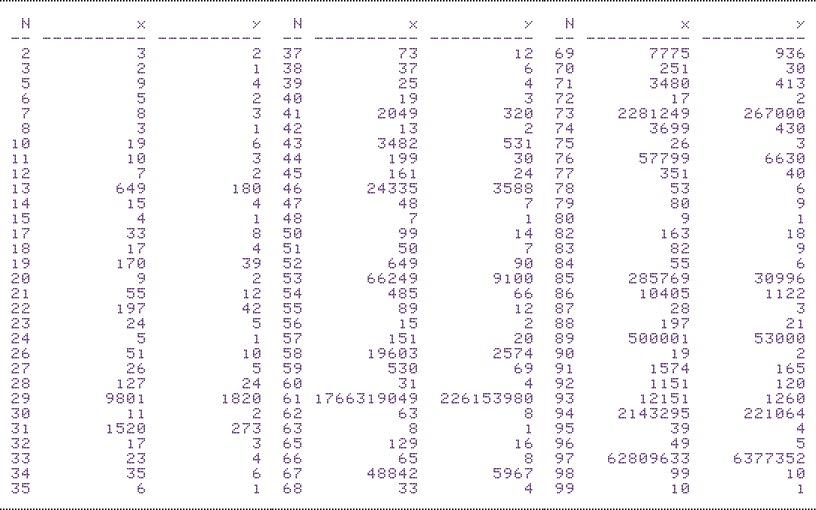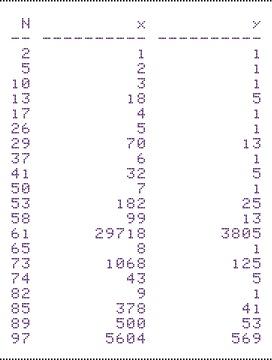| Re: x^2 - N*y^2 = +/- 1 (41CX) Message #25 Posted by Egan Ford on 22 Jan 2009, 12:07 p.m., in response to message #1 by Gerson W. Barbosa Here is my 41CX version. It is not very optimized. Like my 50g solution it will solve for x2 - Ny2 = 1 or x2 - Ny2 = -1. To use, put N and 1 or 0 on the stack (1 if you want to solve for 1 and 0 for -1). Returned to the stack will be x and y. An error is returned for no solution. NOTE: when solving for x2 - Ny2 = -1, N may not have a solution even if not a perfect square, e.g. N = 3. x2 - Ny2 = 1 table created with 41CX PELL (N = 61 took 56 seconds):
x2 - Ny2 = -1 table created with 41CX PELL (N = 61 took 28 seconds):
Source, RAW, and Barcode: http://www.hpmuseum.org/guest/eganford/pell.zip. i41CX+ users can always get my programs on-line here: http://sense.net/~egan/41cx. Source: 01 LBL "PELL" 33 RCL 12 65 X#Y? 97 RCL 08 02 STO 15 34 1 66 GTO 05 98 * 03 X<>Y 35 X#Y? 67 RCL 15 99 RCL 07 04 STO 00 36 GTO 02 68 X=0? 100 + 05 SQRT 37 RCL 15 69 GTO 06 101 STO 09 06 INT 38 X#0? 70 RCL 14 102 RCL 05 07 STO 01 39 GTO 04 71 2 103 STO 04 08 STO 04 40 RCL 07 72 MOD 104 RCL 06 09 STO 10 41 RCL 04 73 X=Y? 105 STO 05 10 1 42 RTN 74 GTO 04 106 RCL 08 11 STO 07 43 LBL 02 75 GTO 05 107 STO 07 12 RCL 00 44 0 76 LBL 06 108 RCL 09 13 RCL 01 45 STO 14 77 RCL 14 109 STO 08 14 RCL 01 46 LBL 03 78 2 110 RCL 11 15 * 47 1 79 MOD 111 STO 10 16 - 48 ST+ 14 80 X=0? 112 RCL 13 17 STO 12 49 RCL 02 81 GTO 04 113 STO 12 18 X=0? 50 RCL 12 82 GTO 07 114 RCL 03 19 GTO 07 51 * 83 LBL 05 115 STO 02 20 RCL 01 52 RCL 10 84 RCL 01 116 GTO 03 21 RCL 10 53 - 85 RCL 11 117 LBL 04 22 + 54 STO 11 86 + 118 RCL 08 23 RCL 12 55 RCL 11 87 RCL 13 119 RCL 05 24 / 56 * 88 / 120 RTN 25 INT 57 CHS 89 INT 121 LBL 07 26 STO 02 58 RCL 00 90 STO 03 122 -1 27 STO 08 59 + 91 RCL 05 123 CLA 28 RCL 01 60 RCL 12 92 * 124 >"NO SOLUTION" 29 * 61 / 93 RCL 04 125 AVIEW 30 1 62 INT 94 + 126 RTN 31 + 63 STO 13 95 STO 06 127 END 32 STO 05 64 1 96 RCL 03 |

